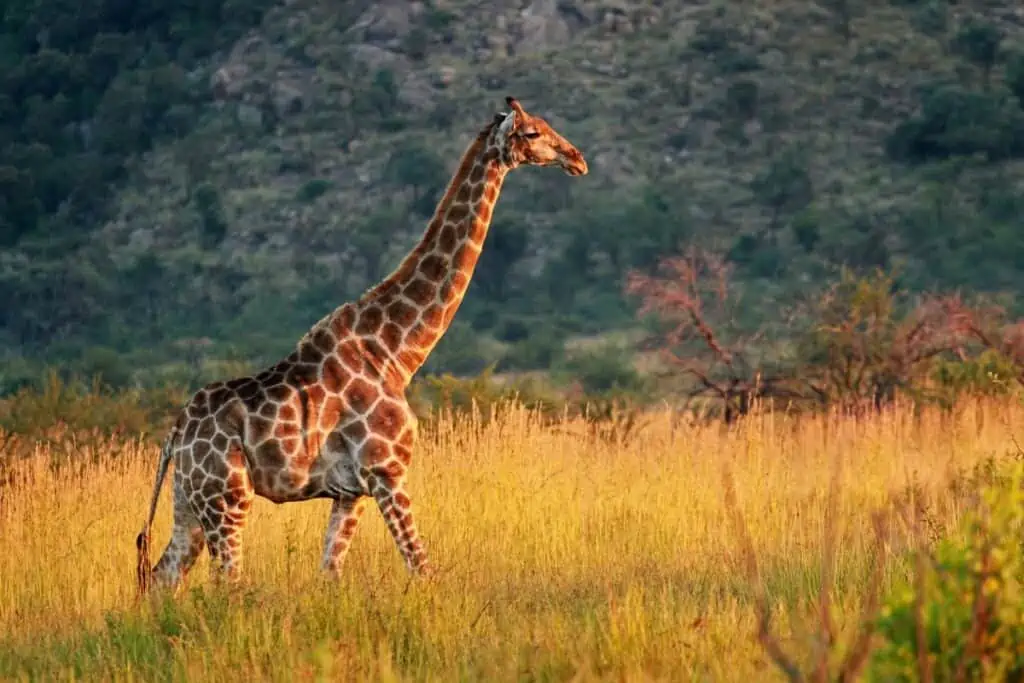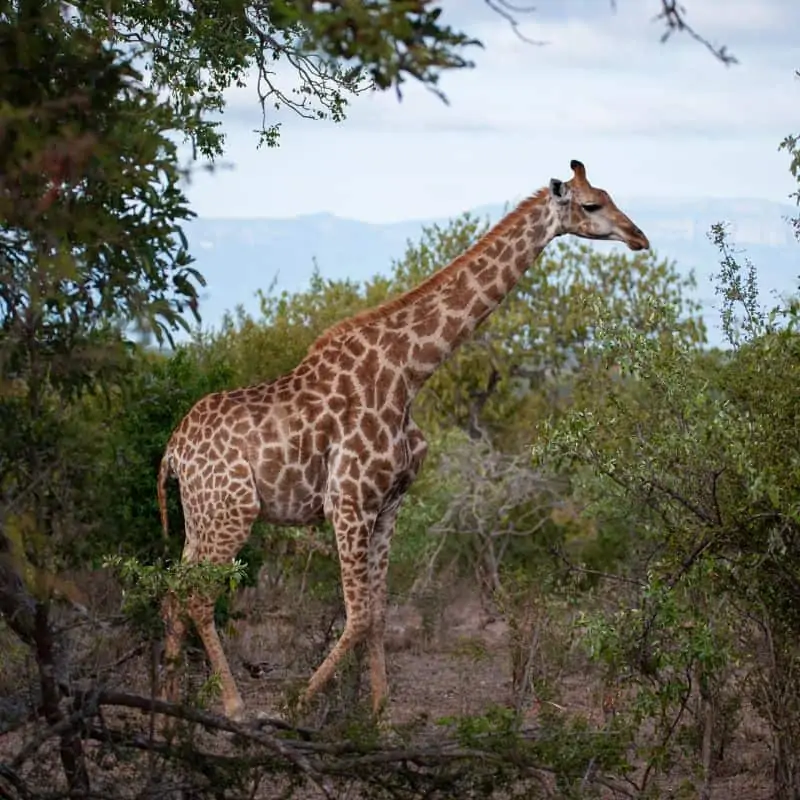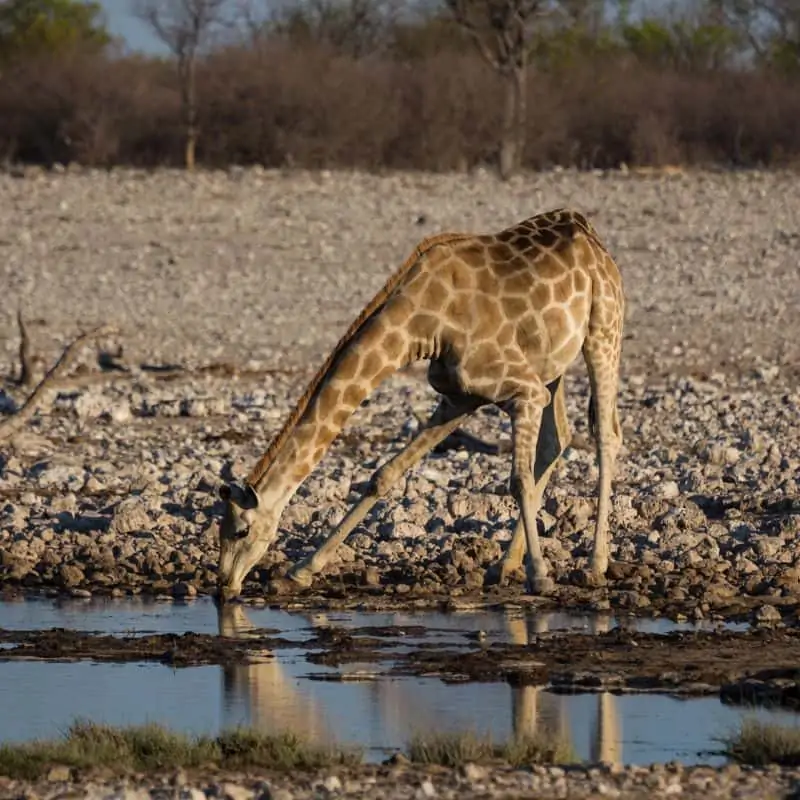Giraffes have always been fascinating creatures. Yet, what’s even more fascinating is how they differ between types.
The southern giraffe is found in countries like South Africa, Mozambique, Angola, and many more. They fall into two subspecies: the Angolan giraffe (or Namibian giraffe) and the South African giraffe (or the Cape giraffe). You can recognize them by their coat patterns, particularly the semi-round patches that get smaller as they go down their legs.
In this article, we’ll dive into more information about the Southern Giraffe, a.k.a. Giraffa giraffe.

When was the Southern Giraffe discovered?
First, let’s go back to the beginning. The Southern giraffe was first discovered (by western civilization) over 200 years ago in 1784 by Johann Christian Daniel von Schreber, a German zoologist.
Throughout its known existence, the Southern giraffe has had several scientific names assigned to it by different researchers.
For example, von Schreber first labeled it the Camelopardalis giraffa. However, a Dutch physician, Pieter Boddaert, later called it the Giraffa giraffa in 1785.
Despite the many different names researchers used, it was Boddaert’s name, the Giraffa giraffa, which became the official scientific name for the Southern giraffe.
Where do Southern Giraffes live?
As the name suggests, Southern giraffes mostly live in the southern part of the African continent. More specifically, they live in African countries like:
- South Africa
- Botswana
- Angola
- Namibia
- Mozambique
- Zambia
- Zimbabwe
Southern giraffes exist in large numbers, and their population continues to grow. They also have few predators that attack healthy adult giraffes, which allows the population to grow even further.
As a result, you’ll find them living freely in protected and unprotected areas across the southern part of the continent.

What are the two subspecies of the Southern Giraffe?
Southern Giraffes are different from the three other giraffe species. However, even among them, there are two subspecies you must know about.
The two subspecies of the southern giraffe are:
- Angolan Giraffe: These are also known as the Namibian Giraffe because they primarily live in northern Namibia, as well as Botswana, west Zimbabwe, and the southwest of Zambia.
- South African Giraffe: These are also called the Cape Giraffe. They’re typically found in the northern part of South Africa, though they’re also in southwest Mozambique, south Zimbabwe, and south Botswana.
How many Southern Giraffes are left in the world?
National Geographic recently reported that there are 48,000 southern giraffes left in the world. This particular species accounts for around 50% of the total giraffe population in the world.
The Southern giraffe population is much larger than others, like the reticulated giraffe. Part of it is because the southern giraffe is not threatened like other types, such as the Northern giraffe, which remains the most threatened species, with the lowest numbers.

Is the Southern giraffe endangered?
No, the southern giraffe is not endangered right now. As already mentioned, the Southern giraffe population is estimated to be around 48,000.
For an animal species to be considered endangered, it must have less than 2,500 mature individuals remaining. As the Southern giraffe population is well above that number, it’s considered to be of least concern by the IUCN Red List.
However, while they’re not endangered, giraffes as a whole are considered vulnerable, and we shouldn’t fall into the trap of thinking these animals are entirely safe from extinction just yet.
Here are some of the primary threats to Southern giraffes and the other types of Giraffes:
- Habitat loss: The first and most significant threat to giraffes is the problems their habitats face. Giraffe habitats (i.e., the places they live) experience fragmentation, degradation, and destruction. With nowhere good to live, giraffes struggle to survive and thrive.
- Poaching: Illegal hunting, also known as poaching, still affects all wildlife in the same regions where the Southern giraffe roams. Unfortunately, poachers also target giraffes of all kinds, threatening their populations.
- Disease: Just like other animal populations, giraffes are also at risk of diseases. For example, viral diseases can spread through giraffe populations, causing weakness, loss of appetite, and death in giraffes.
- Other instability: Lastly, giraffes are threatened by the same instability that affects humans. That includes war, civil unrest, and even climate change. For instance, extreme heat combined with droughts is extremely threatening to giraffes and other animals.
How do you tell Southern Giraffes from other types?
There are several ways you can tell southern giraffes apart from other types.
On top of that, there are also a few identifying features you can look out for to differentiate between Southern giraffe subspecies.
Here are two significant ways you can tell them apart:
1. Geographic location
First and foremost, you can tell Southern giraffes apart based on where they live.
Earlier, we mentioned they live in the southern part of the African continent.
So, when you see a giraffe living in the north, it’s unlikely to be a Southern giraffe.

2. Coat patterns
You can identify Southern giraffes and their subspecies by their coat pattern:
- Generally, southern giraffes are tan in color, with blotched or semi-rounded spots on them. Those patterns go down the animal’s legs to the hooves.
- Angolan giraffes: have larger blotches on their skin that go down to their hooves (like above), but they don’t reach the upper part of their faces.
- South African giraffes: have darker patches that get smaller as they reach the bottom of their legs.
Final thoughts on Southern giraffes
As you can see, the Southern giraffe forms the largest group among all giraffe types.
Despite that, it’s crucial to understand why they have such large populations and also understand the threats that they face.
In doing so, the southern giraffe can be protected, and their numbers can continue to increase, unlike the Northern giraffe, which remains the most threatened giraffe species.

